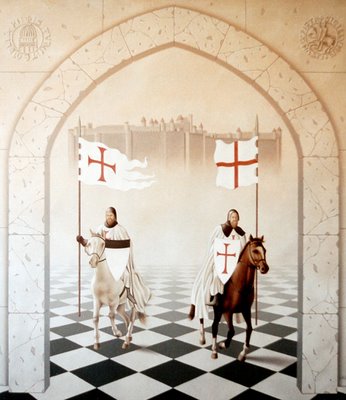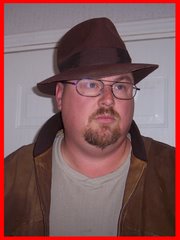 Many of you have no doubt heard of the Knights Templar. But what do we really know about them? Were they gallant Knights sworn to serve Jesus Christ or Heretics? They have been called both and bee called better and worse. Let's take a closer look at them in this first installment of a two part piece on the Knights Templar...
Many of you have no doubt heard of the Knights Templar. But what do we really know about them? Were they gallant Knights sworn to serve Jesus Christ or Heretics? They have been called both and bee called better and worse. Let's take a closer look at them in this first installment of a two part piece on the Knights Templar... According to one esoteric tradition, after excavating the foundations of Solomon’s Temple for nine years the Templar Knights left the Middle East with five “caskets” or cases that were full of treasures they had collected in the Holy Land.
These cases were eventually deposited in Kilwinning, the Mother Lodge of Scottish Freemasonry, before being transported to Roslin Castle, ancient home of the Sinclair Barons of Roslin, where they were kept safe until a fire broke out in the building. The cases were then quickly removed from the castle and very soon afterwards the construction of Rosslyn Chapel officially began. Thus, it appears that the chapel may well have been built specifically to hold the five cases.
This notion was ostensibly corroborated in the 1990s by Andrew Sinclair, who conducted ground scans at Rosslyn and discovered five rectangular objects or boxes in the crypt underneath the Chapel. Sinclair’s discovery has fueled speculation about what might be in the cases. Many suggest the treasure consists of silver and gold trinkets including artifacts associated with Solomon’s Temple or Herod’s Temple, others suggest that there many also be the possibility of finding some ancient scrolls. It has been conjectured that some of the imagined artifacts in the cases were discovered by the Knights via clues they found while studying obscure Essene texts, a theory recently corroborated by the discovery of the Copper Scroll, one of the Dead Sea Scrolls. Clues found in the Copper Scroll have led archeologists to empty pits in close proximity to Templar symbols and weapons, thus apparently revealing that the Knights had overseen the secret excavations and then absconded with whatever treasure they found. The hypothetical scrolls that may exist within the five cases have been theorized to include genealogical information regarding a family spawned by the marriage union of Jesus and Mary Magdalene. Or, assert authors Christopher Knight and Robert Lomas in their fine book, The Hiram Key, possibly Essene information regarding the origins of Freemasonry. But at the present time all that can be said for certain about the scrolls is that one of them contains a diagram with symbols recalling the mysterious Johannite Heresy, a gnostic belief system that the Templars may have been initiated into in the Holy Land. This diagram was copied by Lambert de St. Omer, a retired schoolmaster, when the Templar Knights passed through Flanders as they moved through northern Europe. This diagram, which today is entitled as the Heavenly Jerusalem and hangs on a wall within a museum in Ghent, Belgium, is a map of the New Jerusalem described in the biblical Book of Revelations.
Johannite heretical wisdom is evident in the diagram via the identification of a Messiah – the figure prophesied to found the holy city of the future – as being not Jesus but John the Baptist. Such a designation is consistent with the ancient Johannite heresy, which stated that John was both Messiah and founder of the gnostic Johannite path that leads to the intuitive vision of the Heavenly Jerusalem.
According to this heretical tradition, there were two Messiahs or Chosen Ones, with John, the Priest Messiah, one rung above Jesus, the incarnated King Messiah. If the Johannite Heresy is truly the key to understanding the Templar scroll now in Belgium it must be allowed that the Knights were Johannites and embraced a greater veneration for John the Baptist than Jesus. Furthermore, if they were Johannites then they practiced a gnostic path comprised of heretical rites that culminated in an inner revelation regarding the nature of the universe and the goal of human existence. The truth of this notion would explain why the five cases with their Johannite scrolls ended up in Rosslyn Chapel. The Sinclair builder of the Chapel considered himself to be a caretaker and preserver of the Templars’ gnostic wisdom.
Earl William Sinclair was a Grand Master Freemason of the developing Scottish Rite, an order that had descended directly from the Templars who had fled France and later made their home in Scotland. According to Niven Sinclair, a contemporary patriarch of Clan Sinclair, rather than risk death by exposing the gnostic secrets in his possession Earl William imbedded them within his stone edifice. Perhaps he knew at the time that the secrets he was hiding were for posterity, and that these secrets would prove that the Templars were Johannite gnostics and heretics and so were indeed the Templars’ Biggest Secret.
The Disbelief of Pope Clement V
According to conventional history, the first intimation that the Vatican had regarding the Templars’ gnostic and Johannite predilections came to the surface during the Knights’ depositions for allegations of heresy in 1307. Then, in 1308, Pope
Clement V disbanded the ruthless Inquisition so that he could privately interview the Templar Knights himself. At stake was his own private bodyguard of knights, which since the time of Pope Honorius II and the Council of Troyes in 1128 had been the
Holy Sea’s personal militia. The Knights had been accused of a litany of heretical offenses, any one of which could have been reason enough to cast them straight into the holy fires of the Inquisition, but since many of the Knights’ confessions had been
extracted under extreme torture their credibility had been severely compromised.
Therefore, having himself never fully believed the damning allegations against his beloved Templars, Clement V confidently called for 72 Knights to be transported from Paris to his villa in Poitiers in southern France where he was sure they would recant their previous testimonies. Imagine his surprise when, after insuring the Knights that they were safe in his home no matter how damning their confessions might be, the Templars refused to discredit the confessions previously extracted from them in the dark and dank torture chambers of Paris. Pope Clement, who was essentially a pawn put into office by King Philip, could only scratch his head in disbelief and lament that his Knights had somehow strayed from the straight and narrow. To his dismay he had found out conclusively that all the vile allegations against the Templars, such as kissing each other on the buttocks, and urinating upon the Cross and renouncing Jesus as their Savior in favor of a grizzled, mummified head, were indeed true. The Pope was finally forced to accept the fact that he had lost his knights. Later, within the silence of his quarters the distraught Pope must have wondered whether the Templars had ever truly been a Christian army of the Church.
Truely some weird wild stuff. Join us again Tomorrow for the second part of our piece on the Knights Templar.
I'm Average Joe
 Many of you have no doubt heard of the Knights Templar. But what do we really know about them? Were they gallant Knights sworn to serve Jesus Christ or Heretics? They have been called both and bee called better and worse. Let's take a closer look at them in this first installment of a two part piece on the Knights Templar...
Many of you have no doubt heard of the Knights Templar. But what do we really know about them? Were they gallant Knights sworn to serve Jesus Christ or Heretics? They have been called both and bee called better and worse. Let's take a closer look at them in this first installment of a two part piece on the Knights Templar...
No comments:
Post a Comment